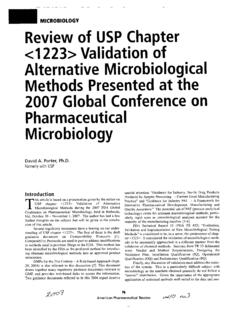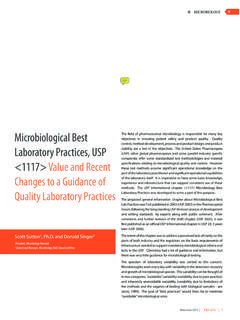Transcription of USP 1116 and Contamination Recovery Rates
1 USP < 1116 > and Contamination Recovery Rates Scott Sutton ABSTRACT united states pharmacopeia (USP) < 1116 > "Microbio-logical Control and Monitoring of Aseptic Processing Environments" approaches analysis of environmen-tal monitoring (EM) data in the aseptic core from a perspective of " Contamination Recovery Rates " while noting a need to improve EM data analysis. There are two difficulties in using EM data from the aseptic core: Most of the plate counts should be "zero" The actual numerical plate counts seen are far below the limit of quantification (LOQ) for the plate count method. USP < 1116 > suggests using "percent Contamination Recovery rate" as the measure, but other options are available: The use of quality control ( QC) control charts has been suggested for these data The use of most probable number (MPN) analysis has been suggested for analysis of these data-this may be a more appropriate method given the Poisson distribution of the data and its very low numbers.
2 Limitations of this approach should also be con-sidered; some tracking of magnitude of excursions as well as trending of microorganism identity throughout the facility is needed. INTRODUCTION The united states pharmacopeia (USP) < 1116 > "Micro-biological Control and Monitoring of Aseptic Process-ing Environments" (1) marks a significant shift in ABOUT THE AUTHOR regulatory thinking regarding microbiological moni-toring of aseptic areas. This shift leads away from arbitrary numerical levels in these extremely clean environments to a more qualitative trending meth-odology. In addition to the important information in this chapter on new ways to set alert and action levels for environmental monitoring (EM) programs, this chapter also stresses the separate and important task of controlling these environments. The following outlines this chapter: Introduction Clean Room Classification for Aseptic Pro-cessing Environments Importance of a Microbiological Evaluation Program for Controlled Environments Physical Evaluation of Contamination Con-trol Effectiveness Training or Personnel Critical Factors in the Design and Implemen-tation of a Microbiological Environmental Monitoring Program Selection of Growth Media Selection of Culture Conditions Establishment of Sampling Plan and Sites Selection of Sample Sites Within Clean Rooms and Aseptic Processing Areas Microbiological Control Parameters in Clean Rooms, Isolators, and RABS Significant Excursions Further Considerations About Data Interpretation Sampling Airborne Microorganisms Surface Sampling Culture Media and Diluents For more Author in1orma\ion, go to Scott Sutton, , is the founder and principal consultant of Microbiology Network, Inc ( n62yFG).
3 He is a recognized consultant and trainer with emphasis in GMP, investigations, environmental monitoring, and Contamination control as well as microbiology laboratory audits and operations. He may be reached by e-mail at ]OURNAL OF VALIDATION TECHNOLOGY (AUTUMN 2012) 79 Identification of Microbial Isolates Conclusion Appendix/Glossary. USP < 1116 > MICROBIOLOGICAL CON-TROL AND MONITORING OF ASEPTIC PROCESSING ENVIRONMENTS The concern about reliable alert and action levels for the aseptic core hinge on two considerations: The limit of quantification for the plate count method The prevalence of "zero" in the data set. This paper will first look at the issues in the limit of quantification. LIMIT OF DETECTION VERSUS LIMIT OF QUANTIFICATION The general ranges in common acceptance for count-able numbers of colonies on a plate are 30-300 or 25-250 colony forming units (cfu). Breed and Dot-terrer noted that, "the kind of bacteria in the mate-rial under examination will have an influence on the size of the colonies, and consequently, on the number that can develop on a plate.
4 " They also noted that food supply can be an issue, that colonies close to each other on the plate may merge, and that neighbor colonies may inhibit growth or conversely stimulate growth. "Because of these and other difficulties certain plates in any series made from a given sample are more satisfactory for use in computing a total than are others. The matter of selecting plates to be used in computing a count becomes therefore a matter requiring considerable judgment (2)." This study determined that plates with more than 400 cfu were unsatisfactory, as were those of less than 30 cfu, with best results in the range of 50-200 cfujplate (2). From this study originated the 30-300 rule for the "countable" range of colo-nies on a plate. Tomasiewicz et al reevaluated the question of countable range on a plate, again taking data from colony counts of raw milk. This study used data from three different experiments (each dilution plated in triplicate) to determine a mean-squared-error of the estimate for all plates.
5 Their recommendation, at the end of the study, was for a countable range of 25-250 cfujplate in triplicate. This study is also notable for excellent cautionary advice. 80 ]OURNAL OF VALIDATION TECHNOLOGY (AUTUMN 2012) "The data presented herein are not necessarily appli-cable to other systems. For automated equipment, the optimum range may well vary with the instru-ment .. Furthermore, even if automation is not used appropriate numbers of colonies that should be on a countable plate can very widely, depending on many other variables. With soil fungi for example .. (3)" USP has recently harmonized a microbial enumera-tion test (4). This test recommends, "Select the plates corresponding to a given dilution and showing the highest number of colonies less than 250 for [total , aerobic microbial count] TAMC and 50 for [total com-bined yeast and mold] TYMC. In determination of the resistance of biological indicators, USP recom-mends a range of "20 to 300 colonies, but not less than 6 (5).
6 " However, the most complete description of the countable range is found in the informational chapter <1227> (6). "The accepted range for countable colonies on a standard agar plate is between 25 and 250 for most bacteria and Candida albicans. This range was estab-lished in the food industry for counting coliform bac-teria in milk. The range is acceptable for compendia! organisms, except for fungi. It is not optimal for counting all environmental monitoring isolates. The recommended range for Aspergillus niger is between 8 to 80 cfu per plate. The use of membrane filtra-tion to recover challenge organisms, or the use of environmental isolates as challenge organisms in the antimicrobial effectiveness testing, requires validation of the countable range (6)." ASTM provides countable ranges of 20-80 cfujmem-brane, 20-200 for spread plates, and 30-300 for pour plates (7). The US Food and Drug Administration's Bacterial Analytical Manual (BAM) recommends 25-250 cfujplate as a countable range (8).
7 The general consensus of these documents is that, at best, the limit of quantification (LOQ) for the plate count method is no less than 20 cfujplate. This leads to direct problems with the currently accepted regula-tory levels that are set near the limit of detection (1 cfujplate) rather than the LOQ (9). Contamination Recovery Rates VERSUS NUMERICAL LEVELS Contamination Recovery Rates in USP < 1116 > are defined as the percentage of plates that show any microbial Recovery irrespective of number of cfu. This term is defined in the glossary of USP < 1116 >. SCOTT SUTTON Table: Suggested initi~l ~ontamination Recovery Rates in_ aseptic ~nvironments. Room Classification Active Air Settle Plate (9 em) Contact Plate Glove or Sample (%) 4 hr exposure (%) or Swab (%) Garment (%) --Isolator/Closed RABS < < {ISO 5 or better) < < --!-----------IS05 <1 <1 <1 <1 ---~----IS06 -~ <3 <3 <3 <3 -----ISO? I <5 <5 <5 <5 ISO 8 <10 <10 <10 <10 This table is reproduced from Table 3 of USP < 1116 > (1) "The Contamination Recovery rate is the rate at which environmental samples are found to contain any level of Contamination .}
8 For example, and incident rate of 1% would mean that only 1% of the samples taken have any Contamination regardless of colony number." The alert and action levels are then defined relative to these percentages. The user is encouraged to collect data and set these averages for the specific facility and sample site (see Table for suggested contamina-tion Rates ). This is in sharp contrast to currently accepted levels of Contamination listed in the 2004 FDA guidance (10) as well as other guidance documents where, in a grade B (class 1000, International Organization for Standardization [ISO] cleanroom six), great signifi-cance is placed on a result of 6 cfu versus 7 cfu (pass/ fail) in active air monitoring or 2 cfu versus 3 cfu in settling plates. All of these numbers are well within the noise level of the plate count method. Note, the FDA Aseptic Processing Guide is used only for illustra-tive purposes without any intention of singling this document out for special mention.
9 All current regula-tory guidance in aseptic processing from Europe and the united states , as well as trade industry technical reports, repeat these, or very similar, action levels. This break with accepted dogma may be the single greatest contribution of this chapter revision. WHY THE MAJOR CHANGE IN FOCUS? The problem with looking at numerical limits for microbiological tests is that the levels have to be rea-sonable in terms of the capability of the method. USP <1227> (1) relies heavily on the established scientific literature in its discussion of this range of countable colonies on a plate (2, 3) to note that colonies have a lower LOQ of approximately 25 colonies per plate. This is opposed to the limit of detection of one colony per plate. EM alert and action levels in the 1-10 cfu range are therefore of questionable accuracy. There is a real need for better quality tools, and this need has led to the shift to Contamination Recovery Rates rather than arbitrary cfu numbers as proposed levels.
10 This chapter is now official (1), and these con-tamination Recovery Rates appear in tables of suggested levels for different classes. The table on suggested initial Contamination recov-ery Rates in aseptic environments (reproduced above) suggests initial Rates (percent Contamination -non-zero-samples) in different areas. The obvious method of implementation for these Rates is on a rolling aver-age, but it is left to the operator to determine the appropriate interval for this average. In addition to the Contamination Recovery percent-age, the role of "significant excursions" ( , excur-sions of approximately 15 cfu on a plate) is discussed. The chapter provides a good discussion of how to evaluate these events for significance, a general input on methodology, and a glossary of terms. While there may be some difficulty with using this particular measure ( Contamination Recovery Rates ) as a trending tool (see discussion below on EM data as normally distributed or in a Poisson distribution), the great contribution of this chapter has to be the recognition that current EM criteria in the aseptic core is completely arbitrary and contrary to good science.




